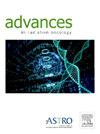锯齿鲍斯韦利亚治疗放射性脑水肿和脑坏死:临床证据的系统元叙述综述
IF 2.2
Q3 ONCOLOGY
引用次数: 0
摘要
目的:立体定向放射手术(SRS)在脑转移(BMs)数量有限的患者中具有良好的局部控制效果,但特别是放射诱导的脑水肿和放射性坏死(RN)可能引起剂量限制性的晚期毒性,胶质瘤分次放射治疗后也是如此。在有症状的患者中,一线治疗标准包括皮质类固醇,然而,在不断发展的免疫治疗时代,这可能适得其反。乳香酸(BA)是一种非处方膳食补充剂,由于其抗炎和抗血管生成的作用,已被认为是一种潜在的皮质类固醇替代品。方法和材料我们对MEDLINE、Embase、Scopus和Cochrane数据库进行了全面的文献检索,确定了在人类脑辐照期间或之后使用BA的出版物。使用现实主义和元叙事证据综合:不断发展的标准框架,使用元叙事方法总结了相关数据。结果共发现6项记录(3项为大剂量放疗后水肿减少,3项为SRS后RN),共130例。大约一半的患者受益于BA(放射学或临床),约三分之一的患者可以成功减少地塞米松或防止其长期摄入。BA的耐受性良好,最常报道轻微的胃肠道不适。目前的缺点包括未知的最佳配方以及时间和剂量,每天需要相当多的胶囊,以及与其他药物的不确定相互作用。总的来说,使用BA治疗放射性脑水肿和RN的临床证据缺乏,需要精心设计的前瞻性试验来进一步研究这种潜在的低成本皮质激素节约选择。本文章由计算机程序翻译,如有差异,请以英文原文为准。
Boswellia serrata for the Management of Radiation-Induced Cerebral Edema and Necrosis: A Systematic Meta-Narrative Review of Clinical Evidence
Purpose
Stereotactic radiosurgery (SRS) yields excellent local control in patients with a limited number of brain metastases (BMs), but radiation-induced cerebral edema and radiation necrosis (RN) in particular may cause dose-limiting late toxicity, with the same holding true after fractionated radiation therapy for glioma. In symptomatic patients, the first-line standard of care includes corticosteroids, which may, however, be counterproductive in the evolving era of immunotherapy. Boswellic acid (BA), available as an over-the-counter dietary supplement, has been suggested as a potential corticosteroid-sparing alternative because of its anti-inflammatory and antiangiogenic effects.
Methods and Materials
We performed a comprehensive literature search of the MEDLINE, Embase, Scopus, and Cochrane databases, identifying publications reporting on the use of BA during or after brain irradiation in humans. Using the Realist and Meta-Narrative Evidence Syntheses: Evolving Standards framework, relevant data are summarized using a meta-narrative approach.
Results
Six records (3 for edema reduction in large irradiated volumes and 3 for RN after SRS) were identified, encompassing 130 patients. Roughly half of patients benefited from BA (radiographically or clinically) and about one third could successfully taper dexamethasone or prevent its long-term intake. Tolerability of BA was favorable, with mild gastrointestinal discomfort being reported most frequently. Current drawbacks include unknown optimal formulation as well as timing and dosing, a considerably large number of required daily capsules, and uncertain interactions with other drugs.
Conclusions
Overall, the clinical evidence on the use of BA for radiation-induced cerebral edema and RN is lacking and well-designed prospective trials are warranted to further investigate this potential low-cost corticosteroid-sparing option.
求助全文
通过发布文献求助,成功后即可免费获取论文全文。
去求助
来源期刊

Advances in Radiation Oncology
Medicine-Radiology, Nuclear Medicine and Imaging
CiteScore
4.60
自引率
4.30%
发文量
208
审稿时长
98 days
期刊介绍:
The purpose of Advances is to provide information for clinicians who use radiation therapy by publishing: Clinical trial reports and reanalyses. Basic science original reports. Manuscripts examining health services research, comparative and cost effectiveness research, and systematic reviews. Case reports documenting unusual problems and solutions. High quality multi and single institutional series, as well as other novel retrospective hypothesis generating series. Timely critical reviews on important topics in radiation oncology, such as side effects. Articles reporting the natural history of disease and patterns of failure, particularly as they relate to treatment volume delineation. Articles on safety and quality in radiation therapy. Essays on clinical experience. Articles on practice transformation in radiation oncology, in particular: Aspects of health policy that may impact the future practice of radiation oncology. How information technology, such as data analytics and systems innovations, will change radiation oncology practice. Articles on imaging as they relate to radiation therapy treatment.
 求助内容:
求助内容: 应助结果提醒方式:
应助结果提醒方式:


